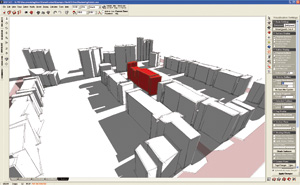

Learn more in the Sun and Shadow Studies in BIM section. Seeing how the sun will move in the sky and shine on your site is helpful for optimizing both passive heating and daylighting strategies. The same sun position as the Vasari image from Nashville, but visualized in Ecotect’s solar position tool and including tabular data. However, Ecotect’s Solar Tool also offers a wide range of solar position tools to help with detailed analysis. This sunpath tool is a more intuitively visual representation of the same data that is available in the Ecotect Weather Tool (Solar Postion tab). Sunset and sunrise times are shown in orange and red. The sunpath diagram on a building placed in Nashville, TN and visualized at noon on the winter solstice, the shortest day of the year (December 21). If you turn shadows on, those shadows will move as you move the sun in the sky. The sunpath tool overlays an interactive dome on top of your model within the design wind so that you can visualize the sun’s position at specific times of day and year. The solar position can be visualized in Vasari, Revit, and Ecotect. Wind data in Ecotect (frequency diagram), also showing wind temperatures, rainfall data, and relative humidity. Strong, cold winds come from the northwest – but not very often. Most of the time the wind blows from the south, and that wind tends to be warm and have a comfortable 55% relative humidity.

The data in Ecotect can also include temperatures, humidity, and rainfall – so you can see if the wind will be warm or cool, wet or dry. In Ecotect: Wind rose diagrams are available in Ecotect in the Weather Tool. Vasari also allows you to overlay a wind rose diagram onto your building site. Static wind rose images for both annual and monthly data are also available as part of every “Results and Compare” report for conceptual energy analysis in both Vasari and Revit.Ī frequency distribution from the Wind Rose Tool in Vasari, showing annual averages. In Vasari/Revit: Interactive wind rose diagrams are available in Vasari using the Wind Rose Tool (it is labeled “Ecotect Wind Rose”, because this functionality originated in that program).
Ecotect weather data file software#
This data is available in Autodesk software in both a “speed distribution” or a “frequency distribution.” Wind rose diagrams plot the wind speed and direction. This diurnal weather chart from Vasari/Revit is also from Nashville, TN. During the summer months the temperature ranges are close to the comfort zone so we’ll likely be able to condition the building passively (although there is a larger temperature swing from night to day). During the winter months, the temperature range is well below the comfort zone, so we’ll likely need to use mechanical heating (though solar radiation is high during the day).
Ecotect weather data file full#
The full range of dry-bulb temperatures is plotted, and wet bulb temperature is not. This graph of diurnal averages from Nashville, TN is from Ecotect. While both Vasari/Revit and Ecotect present diurnal weather data, the two tools present that data differently. Each “column” in the chart shows data over the course of a typical day in that month.

In Ecotect, you can calculate the heating and cooling degree days within the Thermal Analysis tab based on your model and your climate.įor this building in Nashville, TN this Ecotect graph of degree days (DD) shows that you’ll need some cooling in the summer months and (relatively more) heating in the winter months.ĭiurnal temperature data shows daily cycles of temperature and radiation on the site. Heating and cooling degree days ( learn more) is another common way to understand how much heating and cooling you’ll need to do (either passively or actively). With this tool, it is possible to overlay human comfort zones onto the chart, see how much these different passive strategies help expand that comfort zone, and how much energy you’ll be able to save by avoiding active heating and cooling.įor more detail on psychometrics, see the Ecotect Natural Frequency Wiki. A robust psychometric chart tool is available within the Ecotect Weather Tool. Psychrometric charts are the most commonly used tool for analyzing this aspect of the climate. Understanding temperature and humidity can help you determine which passive cooling or passive heating strategies to use.


 0 kommentar(er)
0 kommentar(er)
